Physics 105 - Fall 2014 - Photo Contest Results
I received 170 submitted photos from 99 different students. I chose 3 winners and 23 honorable mentions.
Winners (alphabetical order by first name)
Andrew Germaine - The Human Candle
This is a photo I took from a video I made of myself Fire Eating, while doing a trick called the human candle. How it works is I put the torch in my mouth, while lit, and hold the vapor in it. As I pull the torch out, it lights the vapor and gives the image of a human candle. The physics of it is rather simple; it deals with equalization of air pressure. The air outside my mouth has lower air pressure due to the burning vapor, and inside my mouth has normal air pressure which pushes it out of my mouth and into the burning flame. Then that vapor catches on fire which creates the low pressure and the process continues.
Ashley Ehardt - Discus Thrower
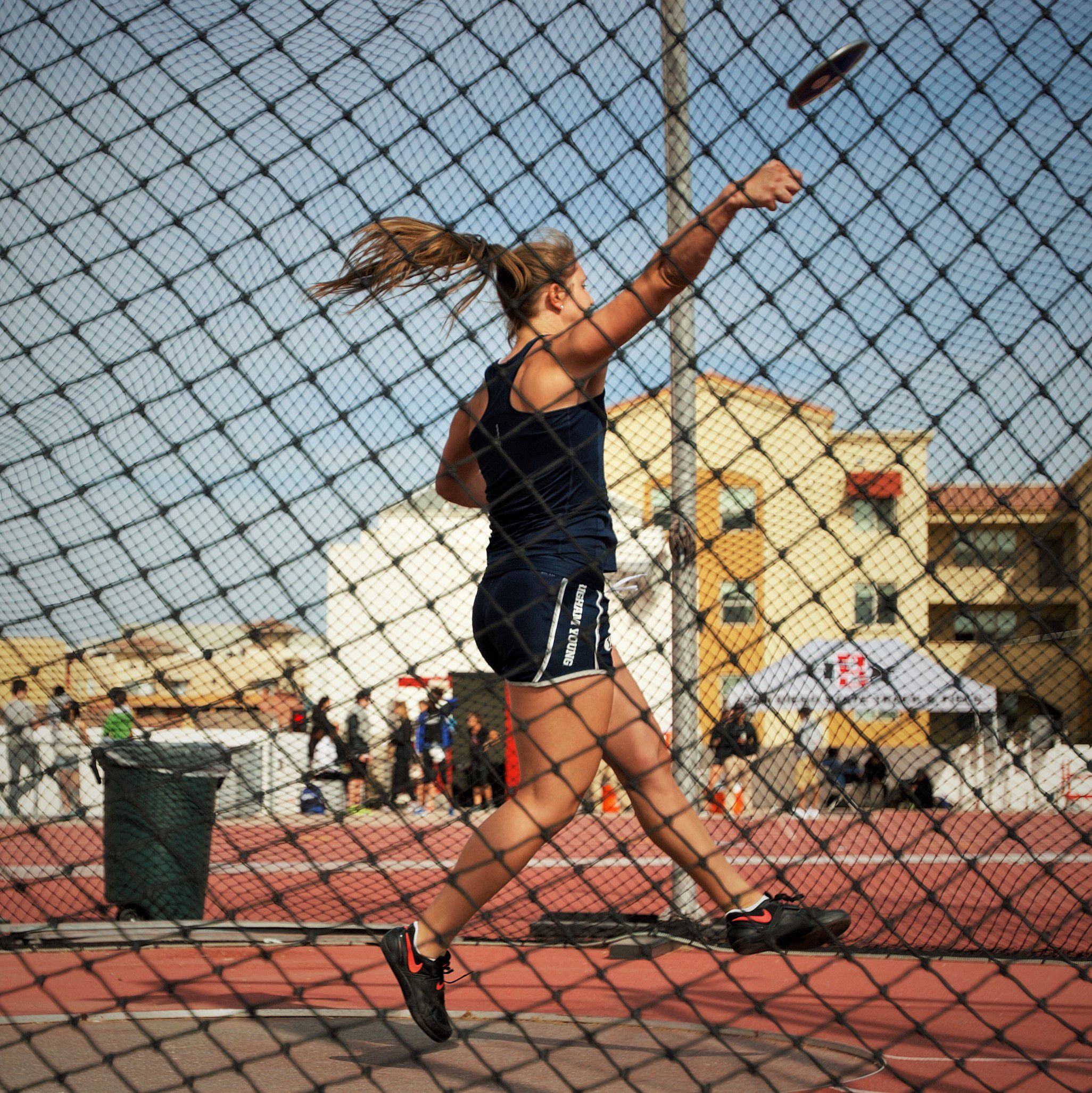
Of all the events in track and field, throwing is perhaps one of the most easily related to physics concepts. Although things such as torque, in relation to the thrower’s arm and body, and centripetal motion, which “holds” the discus in place during the throw, can be identified by most people, very few actually understand the physics behind the discus implement itself. As a newcomer to the discus event, most people will generally begin by throwing a rubber discus; however, as you progress up into the higher, collegiate levels like my teammate in the photo, you will graduate to the more advanced metal discus. So why are rubber and metal discuses so different? It is not as much in the material of the discus itself as it is in the distribution of weight and how it relates to getting enough torque on the discus to provide adequate angular acceleration to carry the discus great lengths. Rubber discuses have an equal weight distribution; there is no significant difference between the rim weight and the center of the disc which means they are considered a solid cylinder or disk. Metal discs, on the other hand, come in a variety of rim weights from 60% all the way up to 90% which makes them comparable to a hoop or a hollow cylinder. From what we have learned about moment of inertia, a solid disk or cylinder has half the moment of inertia that a hollow cylinder or hoop has. This translates back to the equation that the sum of torque is equal to the moment of inertia multiplied by the angular acceleration. Since the rubber discus has half that moment of inertia, it requires less torque to achieve a greater angular acceleration whereas the metal discs require a larger amount of torque to achieve a high angular acceleration. Angular acceleration is a key contributor to tangential acceleration, which then directly contributes to distance as seen through the kinematics equations; it is vital to maximize this concept. Until a thrower learns how to apply the torque correctly to a discus, they will throw much farther using the equally-distributed rubber discuses.
Darrell Hanks - Albanian Pole
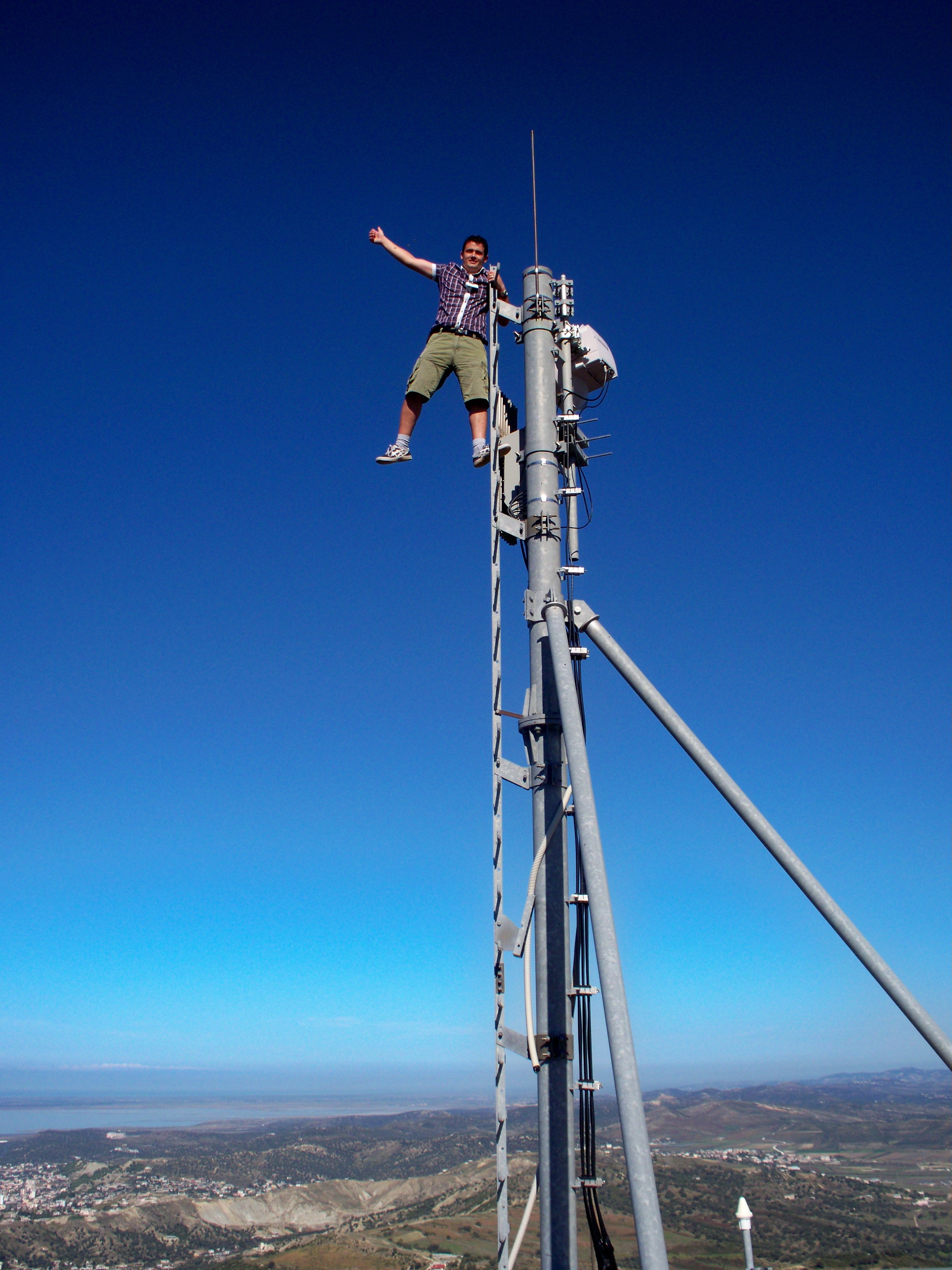
This picture was taken in Vlore, Albania and my companion here, a native Albanian, decided to climb up this pole high above the city and experience a King Kong moment. The physics involved in this photo are the difference between life and death. The upward normal force of the ladder on his foot as well as the tension in his left arm are providing an upward force that is in equilibrium with the downward force of gravity. If the force of gravity were greater than that of the upward forces my companion would plummet to the Earth. This would be devastating. However, on the bright side, another beautiful principle of physics would be demonstrated! At the top of the ladder he has a lot of potential energy. If he were to let go of the ladder he would come flying down with great velocity and his potential energy would be converted to kinetic energy. At the bottom of his fall he would certainly die, but we would know that at least he died doing physics, and that is certainly a happy thought.
Honorable mentions (alphabetical order by first name)
Alli Randall - Atlantic Sea Nettle
This is an Atlantic Sea Nettle, a type of jellyfish. A jellyfish can swim by contracting and expelling water out of its bell, which propels it forward. This works because as the jellyfish exerts a force on the water, the water also exerts an opposite force on the jellyfish, according to Newton's third law, and this force propels it forward. The Atlantic Sea Nettle also has special cells called cnidocytes on its tentacles that are used for defense. When the cell is triggered, usually by touch, calcium ions flow into the cnidocyte, and this concentration gradient causes water to flow into the cell. The high pressure this causes forces the cnidocyte to jet outward and into the unfortunate animal that touched it. The hollow barb sticks into the animal, and toxins are released.
Austin Tyler - Standing Wave
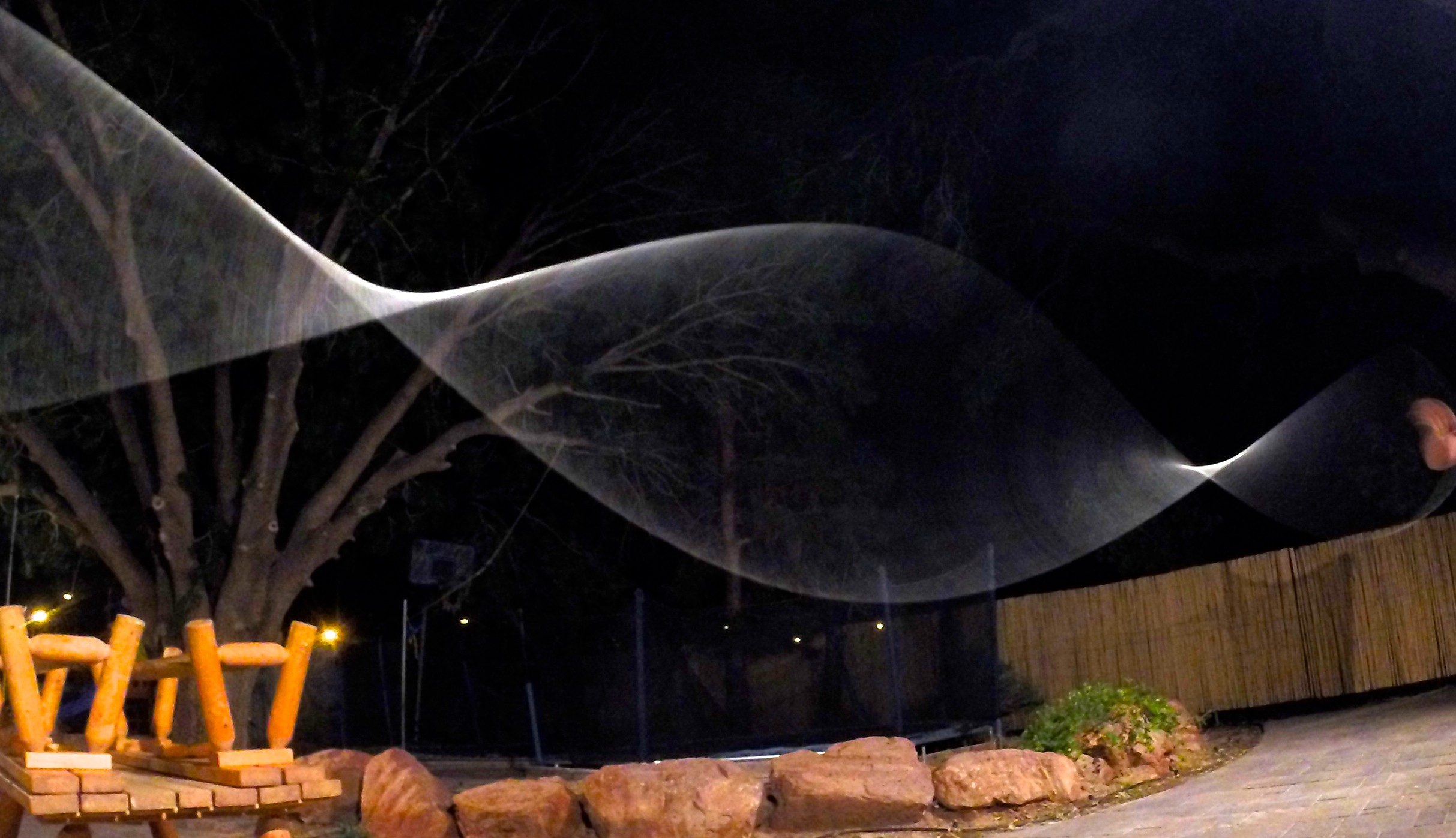
The vibration of this rope is caused by the oscillation of the hand that holds it. The end of the rope opposite the hand is tied to a wooden beam. The hand’s vibration sends waves of energy through the rope. Although these waves appear to stand in the same place, there are reflected waves traveling in both directions along the rope. The appearance of this standing wave is due to the frequency of the waves, which causes interactions that produce nodes and antinodes. The nodes are points of minimal oscillation where the waves seem to cross. The antinodes are in between the nodes at the points of greatest amplitude.
Bailey Benson - Purple Refraction

The difference in speed that results when the medium through which a ray travels changes (a principle called refraction) causes a shift in the angle or direction of the ray. When this occurs to light rays, you can actually see the refraction occurring. In this picture, I have a test tube that is filled partially with water and partially with ethanol. The water is dyed with crystal violet and appears purple, while the ethanol is colorless (the ethanol naturally sits on top of the water because the density of ethanol is less than that of water). I held the test tube in front of a shelf to demonstrate the effect that the water and ethanol would have on the light rays passing through them. As you can see, the refraction of the light rays was significant enough to alter the image of the shelf behind the test tube, and the refraction looks different between the water and the ethanol. This alteration was more dramatic the further away the test tube was from the shelf, and the more I tilted the test tube.
Note from Dr. Colton: I had to look twice (or three times) at the photo to see what she was talking about with how the refraction was different for the ethanol compared to the water. But once I saw it, this became one of my favorite photos!
Brett Schachterle - Back Tuck
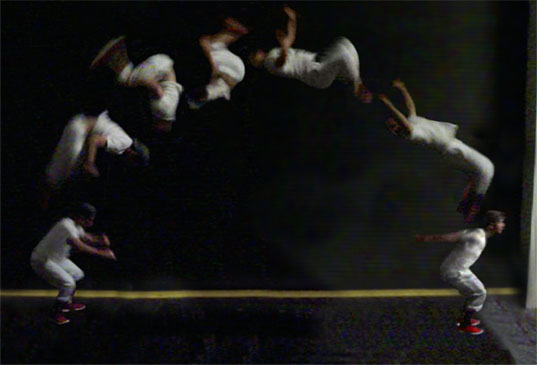
As dancers and gymnasts perform, they often complete moves and stunts which require spins and turns, and even flips, like in this edited photo. The different stages of this flip are all from the same flip, caught in a quick series of images outside the Marriott center. As you look at the flow of images, you can especially see centripetal momentum and acceleration. As the gymnast flips, he pulls his legs up closer to his body, making a smaller radius between his extremities, and his center of gravity. With the smaller radius, he is able to spin faster, and complete the back-flip. You may also notice how his knees act like springs, which initially store energy in preparation for the flip.
Brock Avery - Skateboarding
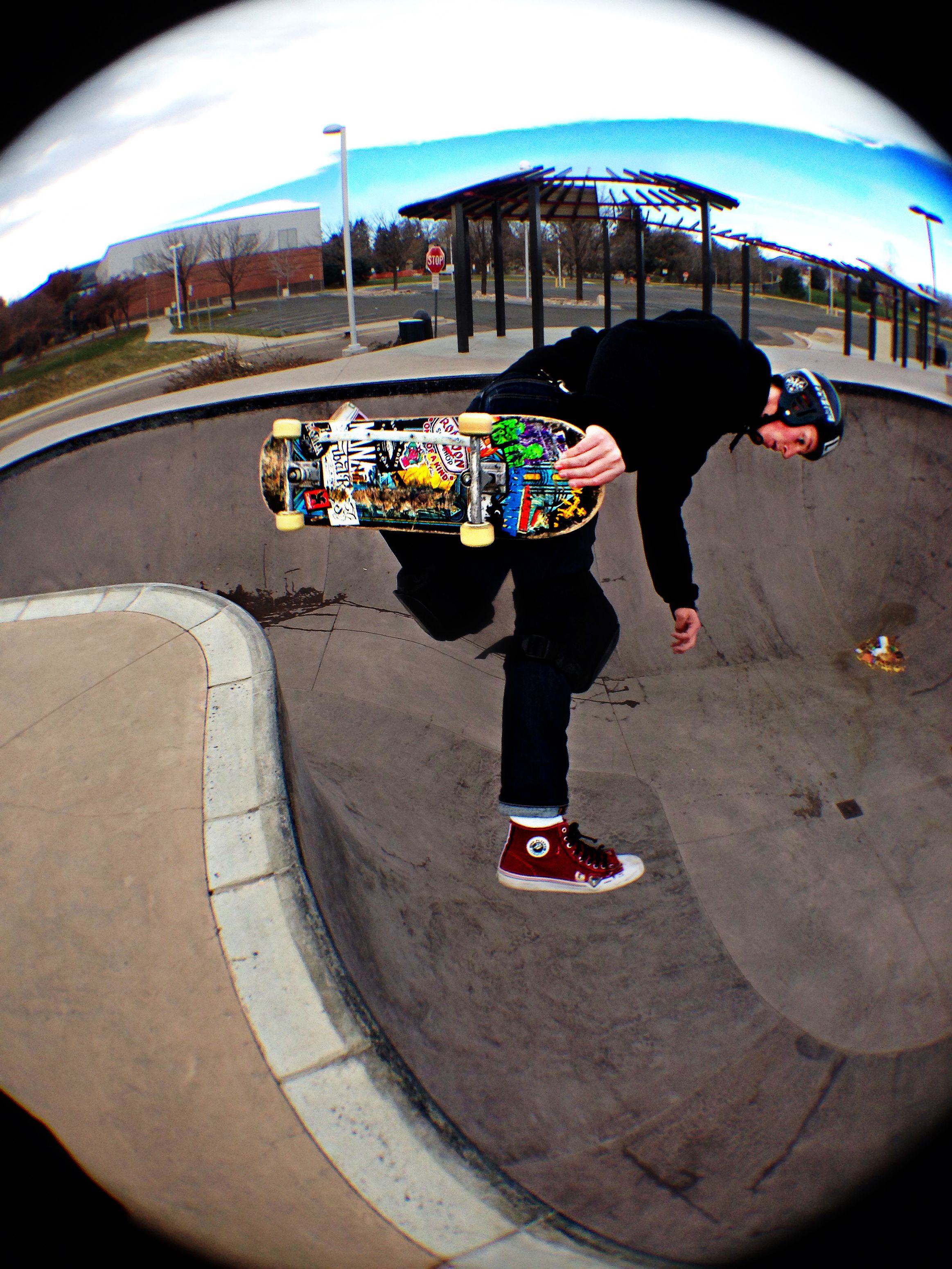
The great wide world of skateboarding is wholly dependent upon the laws of physics. In this particular instance we take part in the experience of flight out of a vert ramp. You might ask what exactly gives the skater the velocity to gain such a height above the coping of the vert ramp. The answer comes from the law of conservation of energy. As the skater carves around the bowl he seeks speed. As he rolls you will notice that he is continually extending and bending his knees at specific parts of the transitions. As he approaches the bottom of the ramp he does so with bended knees, but as he continues up the ramp he extends his legs in preparation for his launch. As he extends, he adds energy through work into his system of energy which consequently increases his velocity. Then as he progresses through to the end of his achieving "air" as the kids call it these days he then reattaches to the vert wall and turns to a skidding safe landing.
Hyrum Wright - Sea Jump
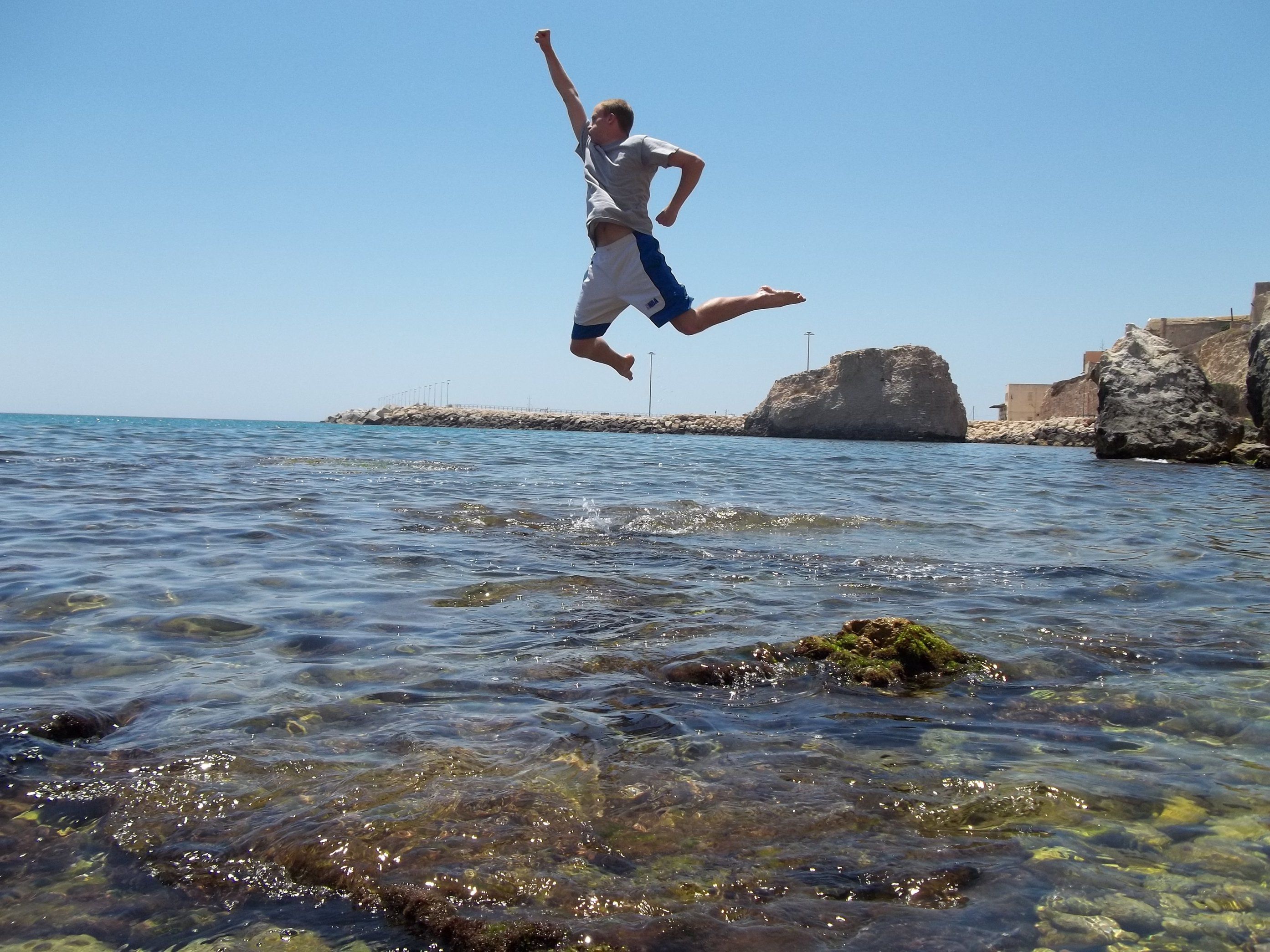
Here our subject is taking flight like a submarine-launched Poseidon missile from the water. He lifted his arms as he leapt, increasing his force pushing downwards on the rocks and water below him. The water pressure on his feet pushing down on them was insufficient to prevent his explosive takeoff. Although the camera captures only one moment in time, we can safely assume from his powerful upward trajectory that he reached escape speed and broke away from Earth's gravity to return to his home planet of Krypton.
Note from Dr. Colton: Points for humor. But wasn't Krypton destroyed?
Jaren Thueson - City Creek Fountain

Not only do Newton’s Laws of Motion help us understand how the universe moves, but they help make the world more beautiful and interesting. Newton’s First Law states, among other things, that an object in motion continues in motion with the same speed and in the same direction unless acted upon by an unbalanced force. According to Newton, the stream of water in the picture would continue on its current path if there were no other forces, including gravity, acting on it. Thankfully, gravity does exists and continually forces the stream of water toward the ground to form a perfect parabola. Additionally, kinematic equations can predict needed initial velocity so the stream falls into the pool of water and not the sidewalk. Newton presented his three laws of motion in 1686, just a two years before the magnificent gardens and fountains were constructed at Versailles. To power these primitive fountains, the French built La Machine de Marly, a massive engineering marvel on the banks of the Seine. According to Jacques and Monique Lay, experts on the Versailles, a staff of sixty people were needed to maintain fourteen paddle wheels, 250 pumps and pipes that carried the water from the river up a five hundred foot vertical rise to the aqueduct that fed the fountains. Consider the amount of energy needed to overcome the forces of friction and gravity in those early pipes. Fountains, like the one found pictured at City Creek in Salt Lake City, are much more economical and efficient because they have electric engines to power the pumps. Whether a fountain was built over three hundred years ago to beautify the gardens of the Sun King or built a few years ago to enhance the serenity of Temple Square, each fountain is governed by the laws of physics.
Jordan Hastings - Tubing

Here a woman enjoys the exhilarating activity of tubing. The inner tube is filled with air less dense than the water, and its buoyant force keeps the tube and woman afloat. As the boat begins to move, the rope connecting the boat to the tube becomes taut exerting a tension force on the tube dragging it across the lake. The water exerts a friction force slowing the tube and boat down, but the motorboat overcomes this with its powerful engine. As it makes turns the woman will be whipped from side to side and experience centripetal acceleration which will make it harder and harder to hold on as the ride continues. Eventually the forces acting on the tube/woman system will win out hurling her into the abyss of the San Francisco delta.
Kensie Greer - Snowboard Launch

This is a picture of my brother Zeke from Christmas day last year. A lot of physics went into making this trick happen. Zeke had gotten a "Banshee Bungee" for Christmas, which is basically a giant sling shot. This photo is on our driveway, which is completely flat. To get the velocity to launch Zeke off the cannon rail, we used the elastic potential energy of the Banshee Bungee. The Banshee is basically like a large sprig. It is pretty difficult to stretch back, so it has a very large spring constant. When Zeke was holding onto the stretched Banshee, this large spring constant gave him a lot of elastic potential energy, which was converted into kinetic energy when the Banshee was released. Thanks to our icy driveway, there was a low coefficient of kinetic friction, so Zeke went sliding rapidly across it. As Zeke reached this cannon rail in the picture, the conservation of angular momentum came into play. The angular momentum of a snowboarder comes from the takeoff, so Zeke started his backward rotation as he was leaving the cannon rail (but still in contact with it). Once in the air, his angular momentum remains constant as he backflips.
Here's a video to show how the Banshee Bungee works: Kensie Greer - Snowboard Launch.mp4
Kent Richter - Sunrise Waterskiier
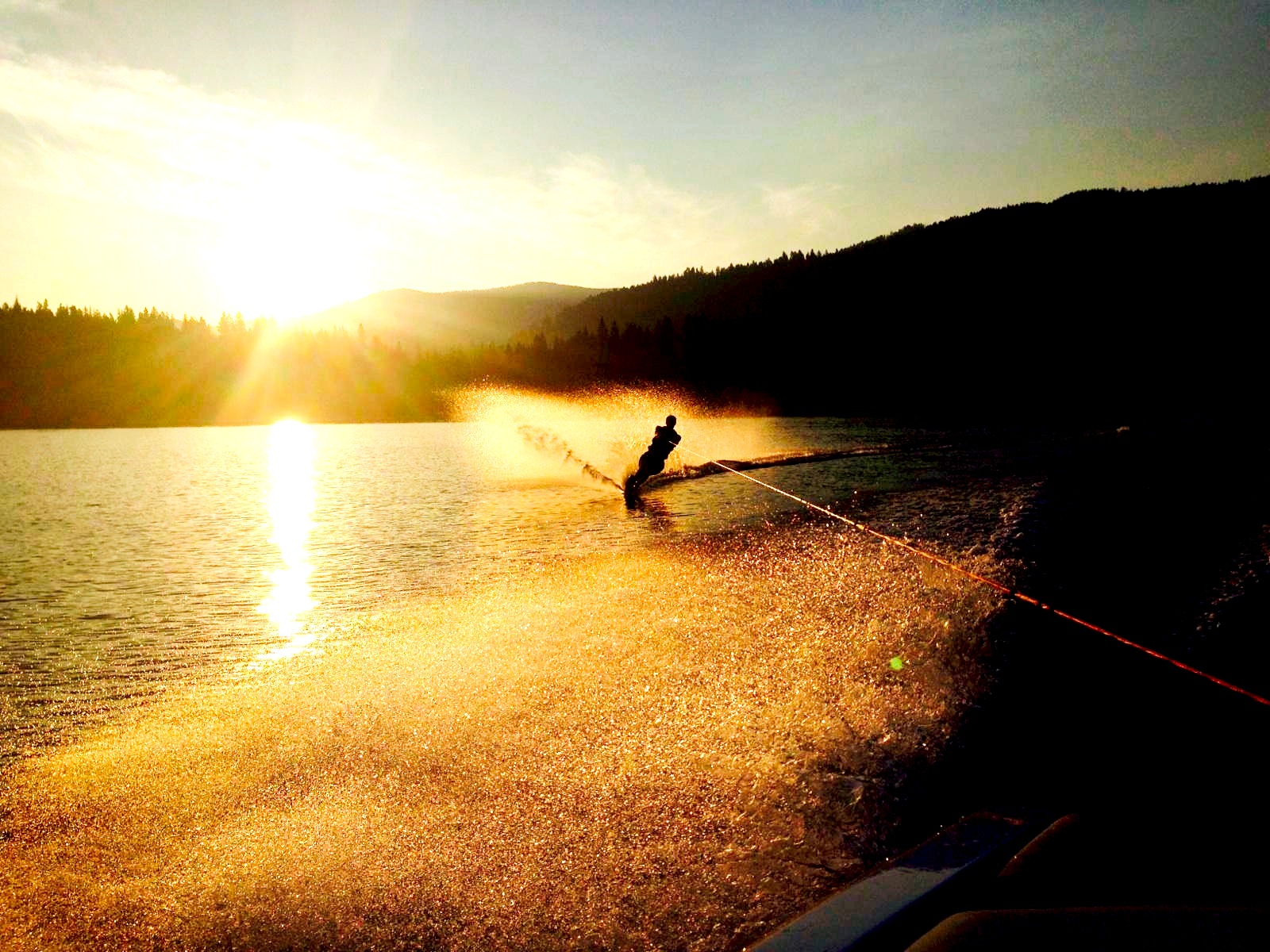
A photo I took of my little brother this summer at Hayden lake in CDA Idaho. Slalom skiing is difficult to do but even more difficult to explain through the laws of physics. First of all Reed had to provide a counterforce against the force of the water in order to stand up. This is done in accordance with Newtons 3rd law; that is for every force there is an equal and opposite counter force. His force downward is created as the boat pulls him forward through the water. The water then pushes him upward allowing him to stand up on the water. As long as there is a constant force forward provided by the boat and his skis stay above water, he will be pushed up by the water allowing him to water ski! But, in the event that he lets go of the rope, or, more commonly for Reed, dips his ski too far under the water, the force of the boat will then propel his ski downward into the water causing him to come to a sometimes very painful stop. Unfortunately I do not have a picture of this dramatic stop, but needles to say it is as funny as it is abrupt. It's fun to have a little brother.
Mallory Jones - Bridal Veil
I took this photo above Bridal Veil Falls up Provo Canyon. After a treacherous hike to the top we found this abandoned structure that was previously a lodge located at the peak of the mountain. In the 1960’s, a cable car would take visitors up the daunting height to the lodge where they could attend dances or indulge in fine dining. In 1996 an avalanche destroyed the lodge, and in 2008 its remains were engulfed in a fire. Six years later, my friends and I found ourselves venturing towards the edge of this metal structure. This pictured section of the lodge jutted out from the mountain, with a luminous 1000+ foot drop below. As my friends walked closer to the edge of the frame, they relied on the principles of torque and tension. The further over the edge they went the greater the torque was, requiring more tension from the beams. Sitting on the edge, I prayed their torque would not be great enough to cause the system to begin to rotate. Luckily it was not, and we were able to enjoy a great view.
Matthew Clement - Tube Accident
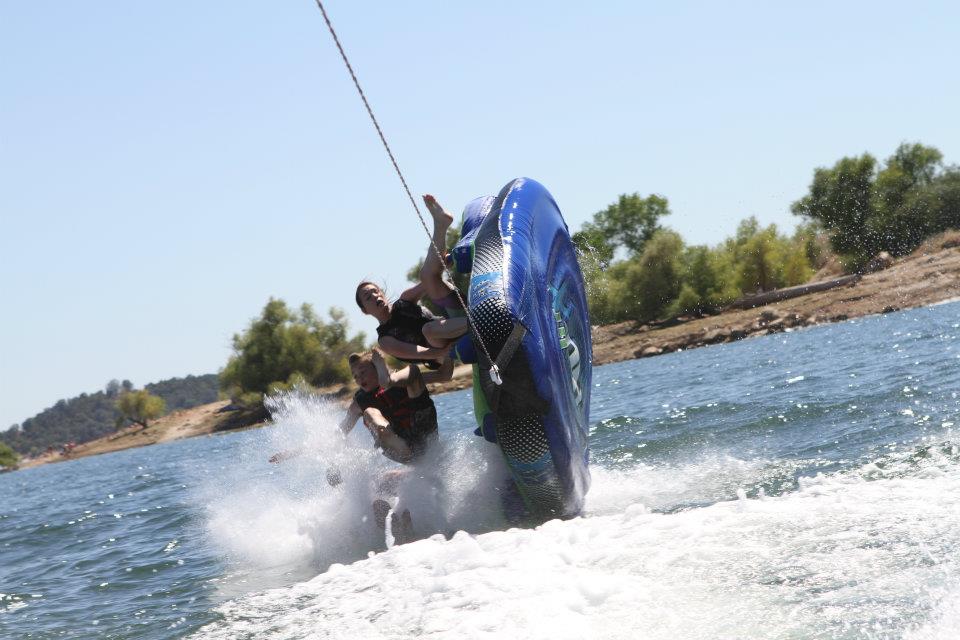
Classics Physics problem, only this one involved a magnitude of pain. Three people are on a inner-tube in the middle of a lake with life preservers on, just in case things get out of hand. The inner-tube hits a wake traveling at a velocity fast enough to cause the tube to become air borne and land sideways, ejecting all three persons. With the life preservers on, all three individuals remain afloat. Did the level of the lake rise or fall after they were ejected from the tube? Archimedes' principle states that the upward buoyant force that is exerted on a body immersed in a fluid, whether fully or partially submerged (as long as it does not sink), is equal to the weight of the fluid that the body displaces. Therefore, since they floated after ejection, the level of water in the lake remained constant.
Orrin Chambers - Hammer and Ruler
Don’t worry! Physics is not broken! Though this situation with the ruler and the hammer appears to defy physics, it is in fact made possible through the principle of torques. The pivot point for the ruler is on the very edge (where my sister’s finger is placed). Normally, the ruler would fall and rotate clockwise (downward) about the pivot point due to the force of gravity because its center of mass is not at the edge of the ruler but in the very middle. However, the back end of the hammer exerts an upward force on the ruler that supports the ruler and keeps it from falling. Looking at the hammer, since the two ends aren’t of equal weight (m x g), the hammer’s center of mass would be located closer to the metal end (if we were trying to balance it horizontally). With the string attached, the hammer’s pivot point is right where the string is tied; the heavier metal end rotates downward in the counterclockwise direction while the back end rotates upward (also counterclockwise). When it comes into contact with the ruler, the ruler also exerts a downward force that is equal and opposite to the upward force exerted by the hammer on the ruler. Thus, these two torques prevent the hammer from rotating upward and the ruler from falling, which gives us a system in static equilibrium. The overall center of mass of the system would be located to the left of my sister’s finger (above the hammer’s head), which is why the ruler stays level and the system as a whole remains in equilibrium.
Note from Dr. Colton: I think the overall center of mass actually has to be directly below the finger. The center of mass of the hammer would be just to the left of the finger, but the ruler shifts the center of mass back to the right so it's directly below the finger.
Rachel Densley - Niece Floating

How is it possible that my one year old niece was able to swim in a lake all on her own? How is it possible that my typically paranoid sister was able to fearlessly cheer her on without a worry or care? The answer lies in physics, with Newton’s second law, and with buoyancy. Any object in water, whether it floats or sinks, has a number of forces acting on it. Namely: the downward force due to the object's weight, and the upward force due to buoyancy. An object will only float if that upward force due to buoyancy is equal in magnitude to the object's weight. This [the upward force from buoyancy] is also known as Archimedes’ Principle. The buoyant force acting on the object depends on three factors: the density of the fluid, the volume of the displaced fluid, and the acceleration due to gravity (g). Without baby Kelly’s tiger floaty, her small body would fail to displace enough water to increase her buoyant force to sufficiently counteract her weight. However with tiger floaty in arm, with its negligible weight and significant volume, she was able to displace a volume of water equal to her own in weight and rise above the surface.
Reaghan Erickson - Trees

I took this photo last summer at a large plantation in South Carolina (which is coincidentally where The Notebook was filmed for Nicholas Sparks fans). While looking at it later, it made me wonder how trees can grow so tall, especially when trees need a lot of water to survive. More tree would mean more water and the taller a tree grows, the larger the distance that water has to travel up the tree becomes. After doing some research on the topic, I figured out that the answer involves pressure and gravity. Gravity is constantly pulling all the water molecules down, so what pulls them up? It turns out trees create a negative pressure system in order to get water up a tree. The farther up a tree you go, the more negative the pressure becomes. While negative pressure can’t exist in gas, in can exist in liquids and is causes by the individual water molecules ‘sucking’ at each other. At the top of the tree, there are only a few water molecules that pull the other water molecules up with negative pressure, thus supplying the whole tree with water.
Robin Char - Food Coloring

This photo was composed using water, extra lighting, filters, and food coloring to illustrate the concept of density. Different colors of food coloring were added to a container of water one drop at a time. The density of the food coloring is slightly greater than the density of water causing it to slowly sink to the bottom of the container. As the food coloring drops it gradually dissociates leaving trails of color showing its path as it travels to the bottom of the container.
Sam Johnson - Petal Droplet

Believe it or not, these mesmerizing water droplets are not in motion-yet! They are currently in a peaceful state of equilibrium between the downward force or gravity, the normal semi-upward normal force from the flower petal, and the semi-upward force of friction. It's awe inspiring how they cling without falling. Although this is a bit more complicated than just simply the force of friction holding them up (water has cool properties that make it special and give it something called hydrostatic friction, as well as surface tension that holds the droplet together) we can still observe basic physics principles. For the moment, each droplet has potential energy stored within it. However, once the balance is tipped some of these droplets' potential energy will be changed into kinetic energy and they will accelerate towards the ground, gaining velocity as they go.
Ty Bodily - Cell Culture

This is a photo taken (with the aide of a microscope) from my neuroscience research. We used a stain called DAPI, which binds to DNA in cell nuclei. Those are the bright dots in the picture. This picture also shows beautiful crystals of dried cell-culture medium. DAPI works by absorbing UV light at a wavelength of about 360 nanometers. Then, it emits light of a larger wavelength in the visual spectrum at about 460 nanometers, which corresponds to blue light.
William Behlke - Soccer
l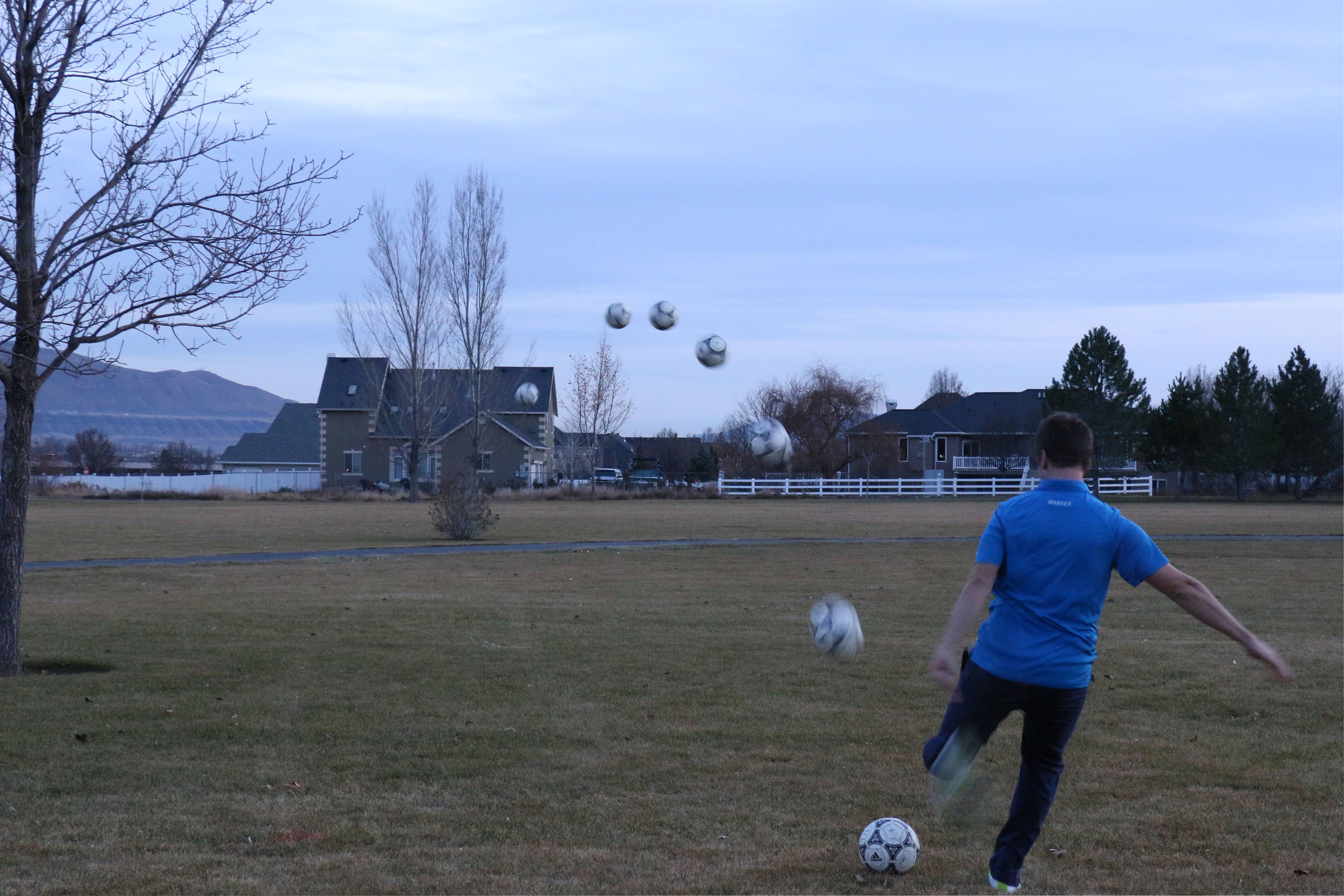
One of the most fascinating things in the game of soccer is how players can get the ball to move in the air in a path other than a straight line, known as “bending”. By striking the ball at a place other than its center of gravity at various angles and speeds, players can get the ball to bend left or right or to dip or rise. Putting a sideways spin on the ball will cause it to bend to the left or to the right. As seen in this photo, a kick with the left foot on the right side of the ball will cause a counterclockwise spin if you were to view it from a position above the ball. As the ball spins, the right side of the ball (the side that was struck) will slow down because it is going against the oncoming airflow. The left side of the ball will increase in velocity because this side of the ball is spinning in the same direction as the oncoming airflow. According to Bernoulli’s equation, as velocity increases pressure will decrease. In this example, as the left side of the soccer ball increases in velocity the pressure on this side of the ball will decrease. The pressure on the right side of the ball will rise. The higher pressure on the right will push the ball to the left where the pressure is lower, causing the ball to “bend”.
William Davis - Guitar
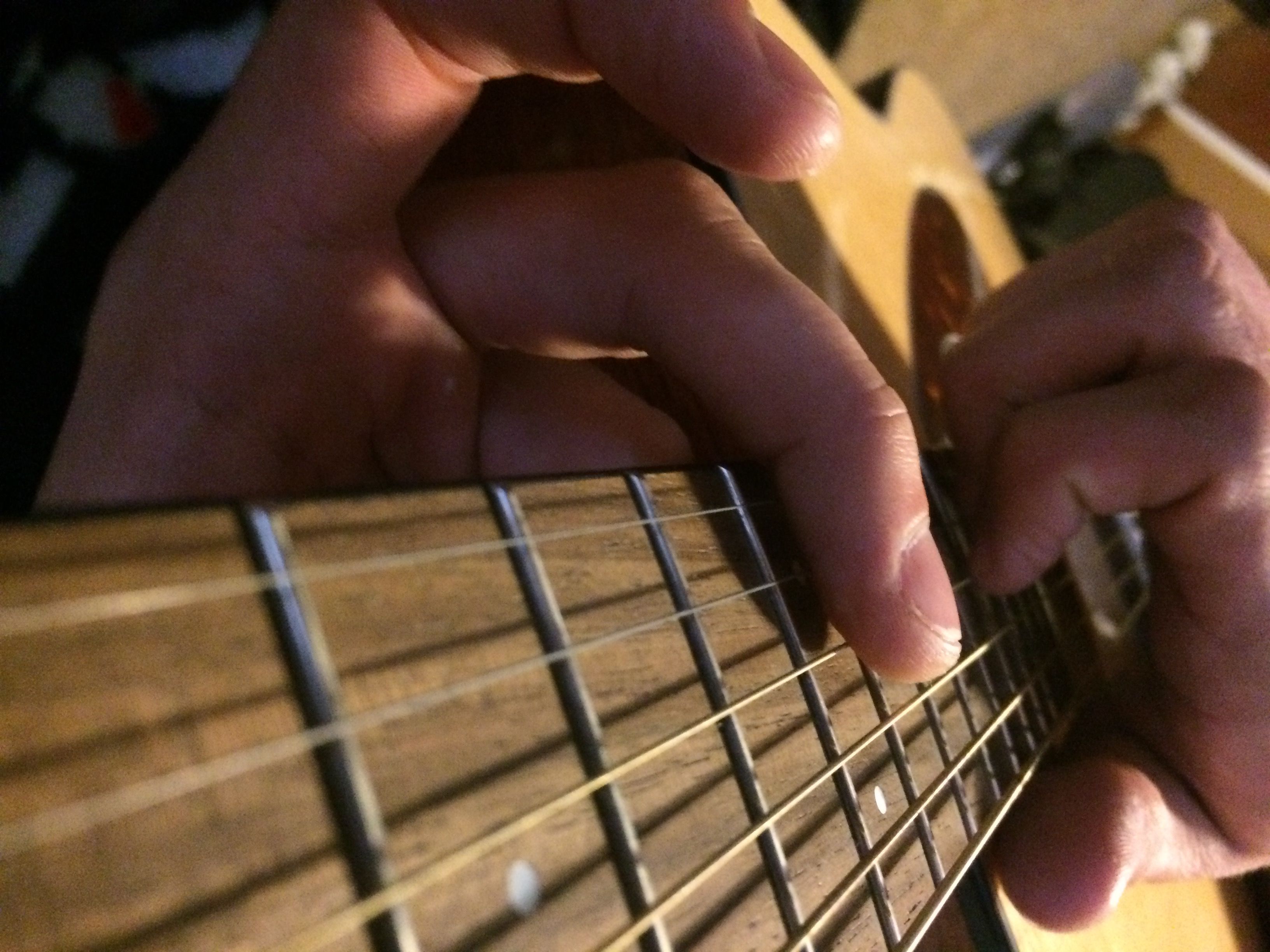
On the guitar you can play normal cords, notes and something called pitch harmonics. A pitch harmonic has a distinctively different sound than that of other notes. That is because playing a normal string on the guitar is a massive mathematical combination of fundamental modes and many Harmonics. (Which still sounds fine) But to produce the distinctly different sound of a pitch harmonic the guitarist chooses a string and then will place a finger over the fret with out pressing. Then plucking the string, and will gently absorb most of the strings initial vibration and then quickly pull their finger away. Physics wise what they are doing is blocking the fundamental mode, and all of the other harmonics except for the desired sound. The picture is showing a guitarist playing pitch harmonics on the G, B and E stings, with the front finger blocking the Fundamental mode and other harmonics that are being created when he picks the strings.
Note from Dr. Colton: To be specific, by putting the finger exactly half way down the string without pressing, the guitar player blocks all of the odd harmonics (including as he said the fundamental, which is the first harmonic). The even harmonics are the ones that will still be present, and the pitch will mainly be determined by the second harmonic.
Zachary Meinzer - Firing Gun

My wife and I recently went up the canyon to shoot some firearms. I was fortunate enough to capture this picture that shows the moment the bullet is leaving the gun. When she pulled the trigger, a hammer was released, which moved a firing pin into the primer of the ammunition, causing it to fire. Newton’s third law of motion states that for every action there is an equal and opposite reaction, so the force on the bullet is the same as the force on my wife. If we were to consider my wife and the bullet as an isolated system, the two would move away from each other with new velocities once the gun was fired. The law of conservation of momentum helps us to understand that the magnitudes of their momenta must be equal. Since she has a larger mass than the bullet, her new velocity will be much smaller than the new velocity of the bullet.
Zachary Meinzer - Island

While on our honeymoon in Tahiti, my wife and I took a scooter ride and noticed a distinct line between the light and dark blue water around the entire island. We also noticed that the light water had smaller waves than the dark water. This was because the particular island we were staying on continued out into the ocean, contributing to the shallow water, and then eventually had a sharp drop-off. When the waves made the transition from the deep to shallow water, some waves were reflected away from the island, so the crests of some waves would meet near the troughs of waves moving in the opposite direction. Since it was not totally destructive interference, some waves got through and eventually made it to the beach. The lack of large waves made it possible to construct the bungalows seen in the picture.
Zachary Motto - Buoyancy Demo
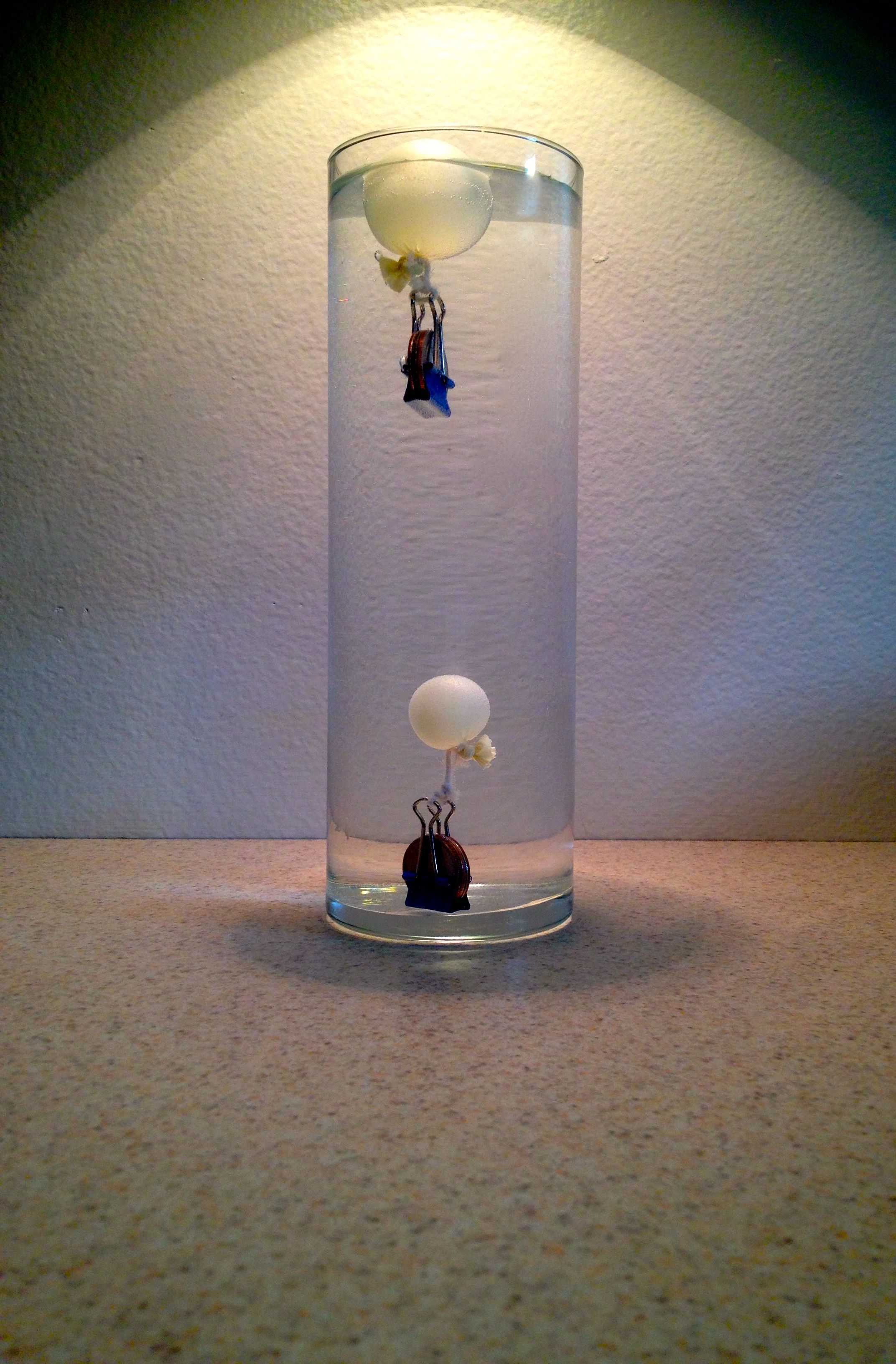
It is reasonable to agree that an 185lb rock thrown into a lake would immediately sink to the bottom. So how is it that an 185lbs is able to float? And what more, how is a person able to float yet has the potential to also sink? It all comes down to the principle of buoyancy. This picture demonstrates a scaled dwon simplified model of how the lungs keep a body afloat. To start, the net force on an object floating is: ΣF= B-mg. That means that when the buoyant force is greater than the force caused by weight, the object floats. But in order to understand how the same weight can float we must look at the equation for buoyancy: Β= ρ(density of the fluid)V(volume of fluid displaced)g(force of gravity). Because the density of the fluid and gravity are constant, the volume directly affects buoyancy. In the picture, one can see that the masses are the same. Both floats have 3 quarters, same string, and same balloon material. The difference is the volume of the total object. As the volume of the object increases, the buoyant force increases to the point that it is greater than the force of gravity. So, in essence, when we inhale, our weight remains the same but our lungs inflate and the volume of our body increases. Looking at the equation for buoyancy, we understand that the buoyant force increases with our volume. Therefore we float when we inflate our lungs.